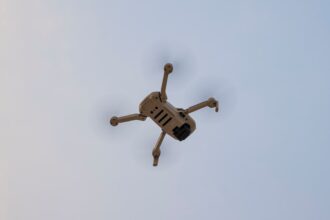Operation Eagle Claw, a pivotal moment in U.S. military history, was an ill-fated attempt to rescue American hostages held in Iran during the 1979 Iranian Revolution. The operation was conceived in the wake of the Iranian hostage crisis, which saw fifty-two American diplomats and citizens taken captive at the U.S.
Embassy in Tehran. The crisis not only strained U.S.-Iran relations but also ignited a sense of urgency within the U.S. government to take decisive action.
As the situation escalated, President Jimmy Carter’s administration faced mounting pressure to resolve the crisis and bring the hostages home safely. The operation was marked by a series of challenges, both logistical and political. The complexities of executing a military mission in a foreign land, particularly one as volatile as Iran, were compounded by the lack of reliable intelligence and the unpredictable nature of the Iranian military response.
Despite these obstacles, Operation Eagle Claw was launched on April 24, 1980, with high hopes for a successful resolution to a crisis that had captured the attention of the world. However, what unfolded would become a significant chapter in U.S. military history, highlighting both the risks of military intervention and the consequences of inadequate planning.
Key Takeaways
- Operation Eagle Claw was a failed rescue mission aimed at freeing American hostages in Iran in 1980.
- The planning and execution of Operation Eagle Claw was marred by logistical and communication failures.
- The failed rescue attempt led to the deaths of eight American servicemen and had significant political consequences.
- Operation Eagle Claw strained US-Iran relations and had a lasting impact on diplomatic efforts between the two countries.
- The legacy of Operation Eagle Claw includes important lessons learned for future military operations and special forces training.
The planning and execution of Operation Eagle Claw
The planning phase of Operation Eagle Claw was extensive and fraught with difficulties. The U.S. government assembled a task force composed of elite military units, including Delta Force and Navy SEALs, to carry out the rescue mission.
The operation’s objective was to infiltrate Iran, secure the hostages, and extract them safely. However, the planning process revealed significant gaps in intelligence and logistical support. The team faced challenges such as identifying suitable landing zones and ensuring that they could operate without detection in hostile territory.
As the operation commenced, it quickly became apparent that the execution would not go as planned. A series of mechanical failures and miscommunications plagued the mission from the outset. The initial rendezvous point for the helicopters was compromised, leading to a chaotic scramble for resources and personnel.
Ultimately, the operation culminated in a disastrous encounter at Desert One, where a collision between aircraft resulted in the loss of lives and equipment. The failure to achieve the mission objectives underscored the importance of thorough preparation and adaptability in military operations.
The failed rescue attempt and its consequences

The failure of Operation Eagle Claw had immediate and far-reaching consequences for both the U.S. military and its foreign policy. The operation ended tragically with eight American servicemen losing their lives in the crash at Desert One, while others were injured or captured.
This loss not only devastated families but also left a profound impact on the morale of U.S. forces and citizens alike.
In addition to the human cost, the failed operation had significant implications for U.S.-Iran relations. The incident solidified anti-American sentiment within Iran and contributed to a long-standing animosity between the two nations. The hostages remained in captivity for an additional 444 days, until their eventual release coincided with Ronald Reagan’s inauguration in January 1981.
This prolonged crisis not only affected diplomatic relations but also shaped U.S. foreign policy in the Middle East for decades to come.
The impact of Operation Eagle Claw on US-Iran relations
| Event | Impact |
|---|---|
| Operation Eagle Claw | Resulted in the failure to rescue American hostages in Iran, leading to embarrassment for the US government |
| US-Iran Relations | Deteriorated further as a result of the failed operation, leading to increased tensions between the two countries |
| Public Perception | The failed operation damaged the public’s confidence in the US government’s ability to handle the hostage crisis and foreign policy |
| Long-term Impact | Contributed to a prolonged period of strained relations between the US and Iran, with lasting effects on diplomatic and military interactions |
Operation Eagle Claw marked a turning point in U.S.-Iran relations, solidifying a rift that has persisted for over four decades. The failed rescue attempt deepened mistrust between the two nations and set a precedent for future interactions characterized by hostility and suspicion. In Iran, the operation was viewed as an act of aggression, reinforcing nationalistic sentiments and anti-American rhetoric among its leadership and populace.
The aftermath of Operation Eagle Claw also influenced U.S. foreign policy in the region. In response to the crisis, subsequent administrations adopted a more cautious approach toward Iran, often prioritizing containment over engagement.
This shift had lasting implications for U.
relations with other Middle Eastern countries as well, as allies observed how America responded to challenges posed by adversaries like Iran. The legacy of Operation Eagle Claw continues to shape diplomatic strategies and military interventions in the region today.
Lessons learned from Operation Eagle Claw
The lessons learned from Operation Eagle Claw have been instrumental in shaping modern military operations and strategic planning within the U.S. Armed Forces. One of the most significant takeaways was the critical importance of thorough intelligence gathering and analysis before undertaking any military action.
The operation highlighted how inadequate information can lead to catastrophic outcomes, emphasizing that successful missions require not only tactical prowess but also comprehensive situational awareness. Additionally, Operation Eagle Claw underscored the necessity for effective communication and coordination among various military branches involved in joint operations. The chaos that ensued during execution revealed weaknesses in command structures and operational protocols that needed addressing.
As a result, subsequent military operations have placed greater emphasis on inter-service collaboration and real-time communication to ensure that all units are aligned and prepared for any contingencies.
The legacy of Operation Eagle Claw in US military operations

The legacy of Operation Eagle Claw is evident in how it has influenced U.S. military operations over the years. Following this failed mission, there was a concerted effort to reform special operations forces and enhance their capabilities for future missions.
The establishment of more rigorous training programs and improved operational planning processes became paramount as military leaders sought to avoid repeating past mistakes. Moreover, Operation Eagle Claw served as a catalyst for advancements in technology and tactics used by special operations forces. The lessons learned from this operation prompted investments in better equipment, including more reliable aircraft and improved communication systems that could withstand challenging environments.
As a result, modern special operations units are better equipped to handle complex missions with greater precision and effectiveness.
The impact of Operation Eagle Claw on US special forces
The impact of Operation Eagle Claw on U.S. special forces cannot be overstated. The operation highlighted both the potential and limitations of elite military units when faced with real-world challenges.
In its aftermath, there was a renewed focus on enhancing training regimens for special forces personnel, ensuring they were prepared for diverse scenarios that could arise during missions. Furthermore, Operation Eagle Claw led to an increased emphasis on joint operations among various branches of the military. Special forces began collaborating more closely with intelligence agencies and other military units to create comprehensive strategies that accounted for all aspects of an operation—from planning through execution.
This shift has resulted in more cohesive and effective responses to crises involving American interests abroad.
The enduring impact of Operation Eagle Claw on US foreign policy
The enduring impact of Operation Eagle Claw on U.S. foreign policy is evident in how it has shaped America’s approach to international crises since 1980. The failed rescue attempt instilled a sense of caution regarding military interventions in politically volatile regions, particularly when hostages are involved.
Policymakers have since been more deliberate in weighing potential risks against benefits before committing troops to rescue missions. Moreover, Operation Eagle Claw has influenced how subsequent administrations engage with adversarial nations like Iran. The lessons learned from this operation have led to a preference for diplomatic solutions over military action whenever possible, reflecting an understanding that direct confrontation can exacerbate tensions rather than resolve them.
The cultural and political legacy of Operation Eagle Claw
The cultural and political legacy of Operation Eagle Claw extends beyond military strategy; it has permeated American society’s collective consciousness regarding foreign policy decisions. The operation became emblematic of the complexities involved in international diplomacy and military intervention, serving as a cautionary tale about overreaching ambitions without adequate preparation. In popular culture, Operation Eagle Claw has been referenced in various forms of media, from films to literature, often highlighting themes of heroism, sacrifice, and the unpredictability of war.
This cultural representation has contributed to ongoing discussions about America’s role on the global stage and how past actions continue to influence contemporary perceptions of military engagement.
The commemoration and remembrance of Operation Eagle Claw
The commemoration and remembrance of Operation Eagle Claw serve as poignant reminders of both sacrifice and failure within U.S. military history. Annual memorials honor those who lost their lives during the operation, ensuring that their bravery is not forgotten amidst broader discussions about military strategy and foreign policy.
Additionally, educational initiatives have emerged to teach future generations about Operation Eagle Claw’s significance within American history. By examining this event through various lenses—military strategy, diplomacy, and cultural impact—students gain insight into how past actions shape current realities in international relations.
the lasting significance of Operation Eagle Claw
In conclusion, Operation Eagle Claw remains a significant event in U.S. history that continues to resonate across multiple domains—military strategy, foreign policy, cultural narratives, and national identity. Its lessons have informed subsequent military operations while shaping diplomatic approaches toward adversarial nations like Iran.
As America navigates an increasingly complex global landscape, understanding the implications of past actions like Operation Eagle Claw is essential for policymakers and citizens alike. By reflecting on this operation’s legacy—both its triumphs and failures—there lies an opportunity to foster more informed discussions about future engagements on the world stage, ensuring that history does not repeat itself while honoring those who served bravely during this tumultuous period.
Operation Eagle Claw, the failed 1980 mission to rescue American hostages in Iran, left a significant mark on U.S. military operations and foreign policy. The mission’s failure highlighted the need for better coordination and led to the eventual establishment of the United States Special Operations Command. For a deeper understanding of the impact and lessons learned from this operation, you can explore a related article on the topic by visiting In The War Room. This resource provides insights into the strategic shifts and military reforms that followed the mission, shaping modern special operations forces.
WATCH THIS! From Tehran to Blackwater: The Real Story
FAQs
What was Operation Eagle Claw?
Operation Eagle Claw was a United States military operation to rescue 52 American hostages held in Iran during the Iran hostage crisis. It took place in April 1980.
What was the outcome of Operation Eagle Claw?
Operation Eagle Claw ended in failure when a number of helicopters encountered mechanical problems and one even crashed into a transport aircraft, resulting in the deaths of eight American servicemen.
What was the legacy of Operation Eagle Claw?
The legacy of Operation Eagle Claw was a reevaluation of the United States’ military capabilities and a renewed focus on special operations forces. It also led to the creation of the United States Special Operations Command (USSOCOM) in 1987.
How did Operation Eagle Claw impact future military operations?
The failure of Operation Eagle Claw led to a greater emphasis on joint military operations and the development of new tactics and technologies to improve the success of future special operations missions.




